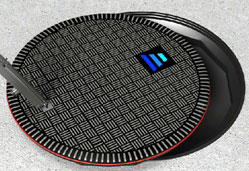In the latest attempt to commercialize technology that can cut the cord for electric vehicle (EV) drivers, a former Army Captain thinks he has the answer.
NY-based HEVO wants to turn the ubiquitous manhole cover into a wireless charger for electric cars.
"I was looking down and saw a manhole cover and thought, that’s the ticket. There are no cords, no hazards. Everything can be underneath the manhole cover," founder Jeremy McCool told Wired.

If his concept takes off, drivers could charge their cars on city streets, in parking lots and garages, and even while they drive on highways – no cord or plug needed.
They simply park over a "manhole cover." A smartphone app helps drivers easily find the power stations, find out if they are vacant and even reserve those that aren’t in use.
"It works the way a tuning fork would," McCool told Fast Company. The charge consists of two coils: one connected to the grid in the manhole cover, and the other on the electric vehicle. When the car runs over the manhole, the coils conduct a "handshake," and the manhole delivers a charge on that frequency to the car.

When McCool returned from Iraq five years ago, he vowed to help the US get off fossil fuels. He got a $25,000 grant from the Department of Veterans Affairs and was accepted by NYC ACRE, the city’s new incubator for cleantech startups. NYU-Poly, one of the partners at the incubator is helping HEVO develop the technology.
He’s applied for a $250,000 grant from the NY State Energy Research and Development Authority (NYSERDA) for the testing phase.
McCool hopes his prototype charging station will debut early next year at NYC’s Washington Square Park. He says he has commitments for pilot fleet programs from City Harvest, Walgreens, PepsiCo and others. Trucks would charge at Green Loading Zones, permanent charging areas at regular pick-up and drop-off points.
Another start-up, Solar Roadways, achieves the same goals using solar panels embedded in the road or parking lots. Car Charging Group (OTCBB:CCGI) has two patents related to dematerializing the charging process: one embeds wireless charging technology in the ground and the other puts it in what looks like a parking bumper.
Nissan, Volkswagen, Audi, Toyota and Mitsubishi are among about a dozen companies developing wireless chargers, not to mention Volvo’s technology, which eliminates the battery altogether.
Whichever technology wins in the end, drivers will eventually be able to charge while parked and driving, and pay for the service wirelessly and automatically.
